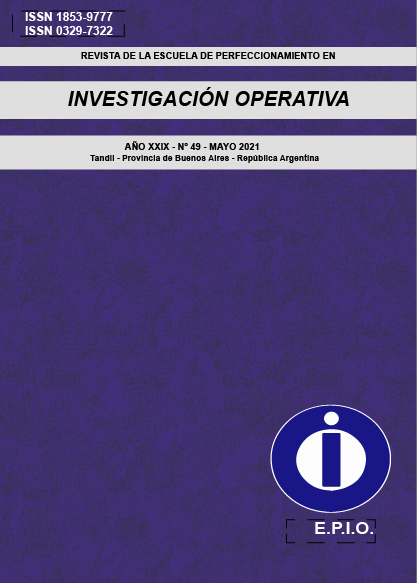Diseño de un agente inteligente basado en una red neuronal artificial supervisada. Validación en un dominio botánico
Keywords:
intelligent agents, smart techniques, artificial neural networks, recognition systems, identification, botanical applications domains.Abstract
Artificial Neural Networks (ANN) were created to simulate the components and functions of the human brain. The properties of ANN enable problems apply in pattern recognition and classification, as they are able to discover no apparent relationships between variables, and both give meaning to data. An intelligent agent whose performance is monitored element models of RNA is described. Validation was applied to the automatic identification of three plant species of Rollinia: R. salicifolia, R. emarginata and R. rugulosa. The constructed and validated models are presented, and the one selected from the best results obtained by evaluating the Mean Square Error and the percentage of errors, this was incorporated into the intelligent agent. The agent consists of a user interface to ensure its use. The proposal may be adapted to other knowledge’s domains.
Downloads
References
Abiodun O. I, Jantan A., Omolara A. E., Dada K. V., Mohamed N A.M Arshad, H. (2018). State-of-the-art in artificial neural network applications: a survey. Heliyon 4 (11). https://doi.org/10.1016/j.heliyon.2018.e00938
Ariza F.J., Pinilla C. y Garcia J. L. (2011). Comparación de matrices de confusión celda a celda mediante bootstraping. Http://Coello.Ujaen.Es/Asignaturas/Pcartografica/Pqcarto/Cpqc28/Bootstrapping_Matrices_Confusion.Pdf. Consulta: 05/02/2011.
Beale M. H., Hagan M. T. y Demuth H. B. (2010). Neural Network Toolbox 7. User’s Guide. The Matworks Inc.
Besnard G, Gaudeul M, Lavergne S, Muller S, Rouhan G, Sukhorukov A P., Vanderpoorten A Y Jabbour F (2018). Herbarium-based science in the twenty-first century. Botany Letters, 165:3-4, 323-327. https://doi.org/10.1080/23818107.2018.1482783
Buonomo Giacoponello, G. E. (2019). Clasificación supervisada de imágenes mediante redes neuronales convolutivas. Proyecto fin de carrera / Trabajo fin de grado, E.T.S.I. de sistemas informáticos (UPM), Madrid.
Castillo E., Cobo A., Gutierrez J. M. y Pruneda R. E. (1999). Introducción a las redes funcionales con aplicaciones. Ed. Paraninfo.
Colmenares, G. (2000). Stratified/PCA: un método de preprocesamiento de datos y variables para la construcción de modelos de redes neuronales. Revista Economía,16:1-31. En Http://Iies.Faces.Ula.Ve/Cdcht/Cdcht%20e2170309b/Articulos/Revista-Economia-16.Pdf.
Hilera J. R. y Martínez V. J. (1995). Redes Neuronales Artificiales. Madrid, Ra-Ma.
Hernandez-Serna, A. y Jimenez-Segura, L. (2014). Automatic identification of species with neural networks. Peerj. 2. E563. 10.7717/Peerj.563.
Jafari M, Shahsavar A (2020). The application of artificial neural networks in modeling and predicting the effects of melatonin on morphological responses of citrus to drought stress. PLoS ONE 15(10): e0240427. https://doi.org/10.1371/journal.pone.0240427
Ledford, H (2017). Artificial intelligence identifies plant species for science, Nature, Doi: 10.1038/Naturaleza.2017.22442
Mariño S. I. y Tressens. (2001). Artificial neural networks application in the identification of three species of Rollinia (Annonaceae): Ann. Bot. Fenicci, 38: 215-224.
Mariño S. I. Y Primorac C. R. (2016). Propuesta Metodológica Para Desarrollo De Modelos De Redes Neuronales Artificiales Supervisadas. International Journal of Educational Research And Innovation (Ijeri), 6, 231-245
Mariño S. I. (2019a). A model of software process generation of a connectionist systems. Journal Of Multidisciplinary Engineering Science And Technology (Jmest) Issn: 2458-9403 Vol. 6 Issue 3, March – 2019, 9676-9681.
Mariño S. I. (2019b). Simulación En La Identificación De Mirtáceas Basado En Redes Neuronales Artificiales Supervisadas, Investigación Operativa, Año Xxvii - Nº 45, Pp. 25-41.
Mariño S. I. (2019c). Modelo De Gestión De Conocimiento Como Apoyo A La Toma De Decisiones Basado En Una Tecnología Inteligente. Descubrimiento Y Validación En Dominios Botánicos, Tesis Doctoral En Ciencias Cognitivas, Universidad Nacional Del Nordeste.
Mariño, S. I. y Alfonzo, P. L. (2017). Una propuesta de integración de interfaces de usuario en métodos de minería de datos. Investigación Operativa, 25 (41): 42-53.
Moller, M. F. (1990). A scaled conjugate gradient algorithm for fast supervised learning. November 13, Computer Science Department University Of Aarhus Denmark.
Piscoya Ferreñan, J.E. (2019). Sistema de visión artificial para apoyar en la identificación de plagas y enfermedades del cultivo de sandía en el distrito de ferreñafe. Tesis para optar el título de Ingeniero de Sistemas y Computación.
Obregón Neira N. Y Fragala F. (2003). Sistemas inteligentes, ingeniería e hidroinformática. Ciencia E Ingeniería Neogranadina, 13, 71-82. Consulta:31/03/2011.Http://Redalyc.Uaemex.Mx/Src/Inicio/Artpdfred.Jsp?Icve=91101308.
Pressmann, R. (2007). Ingeniería Del Software. Ed. Prentice Hall.
Russell S. J. y Norving P. (2004). Artificial Intelligence. A Modern Approach. Prentice- Hall Inc.
Sun Y., Liu Y., Wang G. y Zhang H. (2017). Deep learning for plant identification in natural environment. Comput Intell Neurosci. Doi: 10.1155/2017/7361042. Epub 2017 May 22. Pmid: 28611840; Pmcid: Pmc5458433.
Vargas Sállago, J. M, López Cruz, I. L. y Rico García, E. (2012). Redes neuronales artificiales aplicadas a mediciones de fitomonitoreo para simular fotosíntesis en jitomate bajo invernadero. Revista Mexicana de Ciencias Agrícolas, 3(Spe4), 747-756. Recuperado el 18 de febrero de 2021,Http://Www.Scielo.Org.Mx/Scielo.Php?Script=Sci_Arttextypid=S2007-09342012000900018ylng=Esytlng=Es.
Zaknich A. (2003). Neural networks for intelligent signal processing. World Scientific Publishing Co. Pte. Ltd,
Zhang, L, Kong, J, Zeng, X. Y Ren, J (2008). Plant species identification based on neural network. Fourth International Conference on Natural Computation, Doi: 10.1109/Icnc.2008.253.
L. Zhang, J. Kong, X. Zeng and J. Ren (2008). Plant Species Identification Based on Neural Network. Fourth International Conference on Natural Computation, 2008, pp. 90-94, doi: 10.1109/ICNC.2008.253.
Published
How to Cite
Issue
Section
License

This work is licensed under a Creative Commons Attribution-NonCommercial-ShareAlike 4.0 International License.
Atribución — Usted debe dar crédito de manera adecuada, brindar un enlace a la licencia, e indicar si se han realizado cambios. Puede hacerlo en cualquier forma razonable, pero no de forma tal que sugiera que usted o su uso tienen el apoyo de la licenciante.
NoComercial — Usted no puede hacer uso del material con propósitos comerciales.
CompartirIgual — Si remezcla, transforma o crea a partir del material, debe distribuir su contribución bajo la misma licencia del original.







